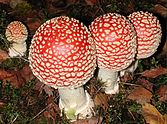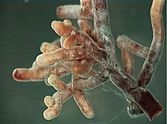
Back متعايشة فطرية جذرية Arabic Micorriza AST Mikoriza Azerbaijani Мікарыза Byelorussian Мікарыза BE-X-OLD Микориза Bulgarian মাইকোরাইজা Bengali/Bangla Mikoriza BS Micorriza Catalan Mykorhiza Czech
A mycorrhiza (from Ancient Greek μύκης (múkēs) 'fungus', and ῥίζα (rhíza) 'root'; pl. mycorrhizae, mycorrhiza, or mycorrhizas)[1] is a symbiotic association between a fungus and a plant.[2] The term mycorrhiza refers to the role of the fungus in the plant's rhizosphere, its root system. Mycorrhizae play important roles in plant nutrition, soil biology, and soil chemistry.
In a mycorrhizal association, the fungus colonizes the host plant's root tissues, either intracellularly as in arbuscular mycorrhizal fungi, or extracellularly as in ectomycorrhizal fungi.[3] The association is normally mutualistic. In particular species, or in particular circumstances, mycorrhizae may have a parasitic association with host plants.[4]
- ^ Deacon, Jim. "The Microbial World: Mycorrhizas". bio.ed.ac.uk (archived). Archived from the original on 2018-04-27. Retrieved 11 January 2019.
- ^ Kirk, P. M.; Cannon, P. F.; David, J. C.; Stalpers, J. (2001). Ainsworth and Bisby's Dictionary of the Fungi (9th ed.). Wallingford, UK: CAB International.
- ^ Wu, Qiang-Sheng, ed. (2017). Arbuscular Mycorrhizas and Stress Tolerance of Plants (1st ed.). Springer Singapore. p. 1. doi:10.1007/978-981-10-4115-0. ISBN 978-981-10-4115-0.
- ^ Johnson, N. C.; Graham, J. H.; Smith, F. A. (1997). "Functioning of mycorrhizal associations along the mutualism–parasitism continuum". New Phytologist. 135 (4): 575–585. doi:10.1046/j.1469-8137.1997.00729.x. S2CID 42871574.
© MMXXIII Rich X Search. We shall prevail. All rights reserved. Rich X Search



